Centrifugal submersible pump: water equipment. The principle of operation and types of submersible centrifugal pumps
The content of the articleWhat are submersible water pumps for? What are the types? How to install this device? Consider these questions in order.
Often in the suburban area there are no centralized water supply systems. However, the need for them is obvious: and not only for personal needs, but also for garden gardens. The best solution to this problem is the use of pumps. Depending on where you plan to get water and for what purposes, you should choose the type of tool. Its main varieties are superficial and submersible.
As the name implies, surface water extracts from the surface of the earth, while submersible is designed for deeper work.
And if you plan to use stocks of underground sources, wells or wells, choose household submersible pumps for water. This relatively small device will be able to automate irrigation and irrigation systems, as well as provide an uninterrupted supply of clean water to your home and to the site. There is even a submersible hot water pump.
How do submersible water pumps work?
The principle of operation of submersible water pumps is simple:
- the device is in a liquid and placed below the surface level;
- using the pressure exerted, the water is pushed up through specially installed hoses and pipes;
- the simplest devices of this kind are able to get water from a depth of 40 m, more technologically advanced reach even up to 80 m;
- depending on the purpose, submersible pumps are divided into two main categories: for clean and dirty water.
Submersible clean water pumps
Submersible pumps for clean water are used to meet domestic needs, watering and irrigation of a summer cottage. They are designed to produce pure liquid from wells, wells, clean rivers, ponds, lakes, etc. As a rule, such devices are multi-stage. This is due to the fact that in order to achieve the goal, it is necessary to reach sources located in deeper layers of the soil, which is possible only with an increase in pressure.
- One impeller cannot cope with such a task. Therefore, in the structure of such pumps several working stages are used, consisting of impellers and diffusers.
- Using multi-stage pumps for dirty and clogged material is highly discouraged. This is due to the fact that at each subsequent upper stage, the pressure increases, and a liquid with a large number of mechanical inclusions is capable of damaging the unprotected surface of the wheel in a short time. As a result, the device quickly becomes clogged, breaks down and will not be able to cope with the task.
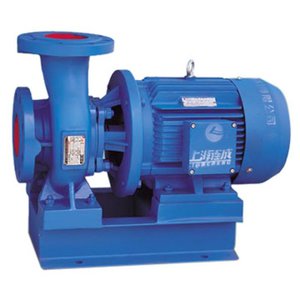
principle of operation and arrangement of a submersible pump
Of course, technological progress does not stand still, and manufacturers are trying to satisfy the needs of customers. The latest modifications to the pumps are designed so that the surfaces of mechanisms in contact with potentially hazardous liquids are coated with durable, protected materials that can withstand pressure up to 300 g / m3.
Two main types of submersible pumps for clean water should be distinguished, depending on the place of their application: well and well.
Well pumps
Well pumps are quite simple and inexpensive devices:
- They suggest pumping water from a depth of not more than 50 m;
- as a rule, such pumps operate according to the vibration principle. Their device involves placing a rubber membrane inside the case;
- on one side of it is a container for the fluid obtained, on the other, a vibrating element that causes the membrane to change shape.
At different stages of operation, the membrane bends, this entails a change in pressure. So, when the pressure decreases, the inlet valve opens to start the next portion of water, when the pressure increases, on the contrary, the outlet valve opens, and the liquid enters the outlet hose.
It should be borne in mind that the diameter of such devices is large, so the possibility of their use is quite limited: in wells, wide wells.
Well pumps
Deep water pumps operate on a completely different principle from the above, in connection with which they are able to get water from the deepest and narrowest openings. This also explains the noticeable difference in the price of centrifugal submersible water pumps.
- The pump includes an impeller, consisting of disks fastened together by bent blades;
- water, getting inside, is under the influence of centrifugal force;
- energy is created by rotating the wheel. The blades, moving at high speed, form in the center a low-pressure region, and along the perimeter, respectively, - increased;
- water, falling under the influence of the pressure difference, rushes to the center, and through the outgoing pipe goes out.
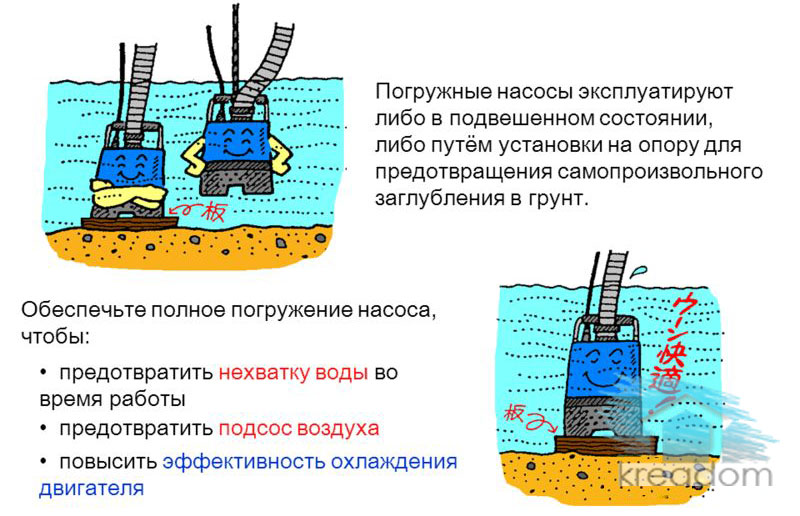
Installation options and proper operation of submersible pumps
Drainage pumps
Very often there is a need to pump out contaminated masses: cleaning the swimming pool, destruction of sewage and sewage.
Using conventional pumps, which we considered above, is extremely impractical for these purposes. They are not intended for this. Firstly, such devices will demonstrate low efficiency: they will work slowly and poorly. Secondly, in the shortest possible time they simply break down due to excessive load.
To perform such tasks, there are special drainage submersible pumps. Submersible pumps for wastewater There are also several types. It all depends on why and how you plan to use them. And the methods of application are, as you know, different.
How to install a submersible pump yourself
In order to install on your site submersible pump for pumping water, it is easiest to use the services of specialists. They will cope with the task quickly and skillfully. If you have a desire to do it yourself in order to save money or just feel like a jack of all trades, this is also nothing supernatural. In fact, the installation process of the pump is quite simple:
- you will need: brackets, couplings, cable, cable, pipe and, in fact, the pump itself;
- if its use is intended for watering the garden, you should also stock up with a hose. First of all, a pipe or hose is attached to the pump (depending on your plans). After dealing with this, connect the cable;
- it is not necessary to move and raise the pump, holding on to a hose or cable - you may damage the unit;
- specifically for such purposes, we stocked up with a safety cable. After that, lower the pump, check everything again, and start it at idle.
- Take a break within an hour after the test run.
We have developed our own resource laid down in them by designers, you just need to follow the rules for their operation. Often, mean, dry phrases from the instructions remain incomprehensible to us, which means they don’t "come to mind", we simply ignore them. And in vain, for the price of this burnt downhole pump, the village left without water. Let's start with the design of the well pump.
Submersible water pump consists of a submersible water-filled electric motor and a centrifugal well pump, as a rule, having several steps. The steps are mounted on the shaft of the pump 11 and with the help of ties 3 are attached to the base 16 of the pump. On the other hand, an electric motor is attached to the base.
The stage of the centrifugal submersible pump consists of a cage 7, in which a ring 8 and a blade vane 6 (LO) are fixed, as well as an impeller 9 (PK), mounted on the shaft of the borehole pump using a key 12. The spacer bushings 10 are fixed to each other on the shaft of the RC .
The shaft bearings are the upper and lower rubber bearings. The upper bearing 4 is located in the housing 5, to which the head of the pump 1 with a check valve 2 is attached. The head has a tapered thread for connecting the pump to the lifting column.
Bearings are lubricated by pumped water.
The lower end of the ECV pump shaft and the rotor shank of the electric motor rotor are interconnected by means of a clutch 15 and keys 13 and 17.
Adjusting washers 14 are installed between the shaft and the shank to set the necessary clearance between the RC and the LO.
The borehole pump electric motor is a three-phase asynchronous with a squirrel-cage rotor and an insulated neutral wire. The windings of the phases are connected by a star.
On the stator housing 20, upper 19 and lower 24 bearing shields are fixed, as well as a ring 25 for attaching the bottom 30 with thrust axial bearing elements to the stator housing. Each shield has two bearings 21. A package of plates of the magnetic circuit 22 is pressed inside the stator housing, forming grooves for laying the stator winding. The stator winding is made of a special winding wire type PVDP with polyethylene insulation, capable of ensuring the operation of the motor completely immersed in water. The ends of the windings are brought to the surface using an immersion cable 18 type runway.
The rotor 23 has a conventional squirrel cage design with aluminum or copper conductors. A heel 26 is fixed at the lower end of the rotor using a key and a retaining ring. The heel and thrust bearing 27 together with the sphere 29 form a thrust bearing assembly for absorbing hydraulic axial forces, as well as the mass of the rotor of the electric motor and pump for wells.
Before installing the submersible pump in the well, the electric motor is filled with water. Water is drained through a special plug 28 in the bottom. Water is used to lubricate bearings and cool the stator. The base is covered with a mesh to prevent large mechanical impurities from entering the well pump.
Having more or less clarified for ourselves how the submersible pump is designed for wells, we will understand more clearly the requirements that manufacturers impose on the operating conditions of the submersible well pump. Conventionally, they can be divided into installation and workers. The first covers the range of rules for preparing for installation and its implementation, the second - the range of rules that must be observed when operating an electric pump.
Before mounting the submersible pump into the well, the following work and checks must be done.
In some cases, during prolonged transportation or storage, the preservative compound hardens and washing twice is not enough. In such cases, it makes sense to leave the electric motor filled with water for a day. This must be done without fail if the pump shaft for the wells does not rotate.
To check rotation, a number of holes are provided on the coupling, where the lever is inserted. In some cases, rotation can be checked from the head of the submersible pump using an allen wrench (or a screwdriver in the case of four-inch pumps) worn on a mounting nut from the upper end of the pump shaft. In the event that for some reason the shaft does not rotate, or rotates with difficulty, jamming, its operation in the well will necessarily lead to failure. In the best case, the service life will simply be reduced. Suppose a preservative is not sufficiently washed, or polystyrene RK has injection flows. Both that, and another after some time of operation of the submersible pump will be eliminated, however the increased moment of resistance, and, consequently, the increased load current until the moment of elimination will contribute to electrothermal aging of the stator winding insulation.
Filling with water is carried out through a special hole in the upper bearing shield of the electric motor, which is closed by a mesh stopper-filter during operation. Some designs of electric motors have mesh plugs filters instead of drain plugs. In this case, the filling of the well pump engine occurs spontaneously in the well, when the pump is immersed in water. After immersion, before starting the well pump, wait at least 15 minutes to completely fill the engine with water. It is strictly forbidden to lower the submersible pump into the well without a drain plug. This is due to the fact that it increases the likelihood of sand and other mechanical impurities contained in the pumped water getting into the engine, which leads to abrasive wear of the heel and thrust bearing, subsidence of the motor shaft and the submersible pump and, as a result, mechanical damage to the RC and LO.
The most important electrical parameter of an electric motor is the insulation resistance of the stator winding, which is measured after the motor is filled with water.
In the case when the drain hole is closed with a strainer plug, it is possible to measure the insulation resistance when the submersible pump is immersed in a tank such as a bathtub or barrel. It is important that the well pump motor is fully submerged. This is not entirely convenient. Long-term practice of incoming control of electric pumps coming from the factory has shown that if the resistance measured "dry" has a value of more than 500 megohms, then, as a rule, in the filled state, the resistance value will be normal. This is due to the fact that if there are defects in the insulation, the humidity contained in the atmospheric air will noticeably reduce the value of the insulation resistance. You can use this circumstance and not fill the engine with water. However, if the resistance is below 500 MΩ, the measurement will have to be done in a state filled with water.
After checking the insulation resistance of the electric motor, a current-supply cable is connected to its terminals.
The measurement is made by attaching the test lead to one end of the megohmmeter, and a metal vessel with water to the other end of the device. It is important to verify the integrity of the insulation of the winding and the lead-in cable with the connection point before lowering the pump into the well, since possible cable damage during installation will be reliably determined only in this case.
When installing a submersible water pump in a well, the following requirements must be observed:
First of all, the current lead cable spoils during installation. Defects occur due to cable bending, mechanical damage to the riser pipes, cable damage to the casing when the submersible water pump is lowered into the well.
In other words, it is important to protect the cable from mechanical damage during installation work, since with normal insulation resistance of the engine and the joints, the unit will have to be dismantled if the total resistance of the cable-engine system is below 10 MΩ.
After installing the submersible pump and the head of the well, it is necessary to connect the equipment of the wellhead and casing with the ground loop pumping station in accordance with the PUE.
When installing a downhole pump in the filter zone, the cross section of the well at this location is significantly narrowed. In this case, the flow rate of pumped water in this section sharply increases, which leads to the removal of sand from the filter. As a result, the abrasive wear of the working parts of the pump for wells will lead to its failure.
The calculation of the electrothermal regime of a submersible water pump takes into account the cooling effect of the water flow around the stator. The speed of this flow for normal cooling should be at least 1 m / s. This condition is achieved by matching the diameters of the casing and the submersible pump. Suppose a 6 "pump is located in an 8" or 10 "column, and the cross section between the column wall and the stator surface will be larger and the flow rate will decrease, impairing cooling. This in turn will cause an increase in the stator temperature, and hence the windings, which is inevitable will lead to accelerated aging of the insulation and its deterioration.This circumstance dictates another requirement related to
operating conditions.
With a fully closed valve, the flow rate is zero, therefore, the flow rate of cooling water around the stator is also zero. Hence the increase in temperature of the winding and accelerated wear of the insulation. Any wear of the insulation leads to a breakdown on the housing and the failure of the submersible pump.
For the same reason (accelerated wear of insulation), the frequency of turning on the well pump is limited.
Each inclusion of a pump for wells is accompanied by inrush currents that determine the occurrence of modes similar to emergency ones.
The switching frequency is determined by the action of automation, which turns on the pump for wells when the lower water level in the tower is reached and turns off the pump when the upper water level in the tower is reached. The difference in altitude is determined by the design of the level sensor, which is designed so that at the highest flows of the submersible pump, the maximum frequency will remain below the permissible level.
Based on our many years of practice service pumps for wells, we gave those moments of pre-installation preparation, installation and operation of submersible pumps, the neglect of which most often led to the failure of the water pump.
Our company has the ability to supply a full range of industrial pumps. You can familiarize with the assortment and technical characteristics on the website page.
Centrifugal submersible pumps are the most common type of equipment for pumping water, used both in the home and for production needs. Surface pumps can reach a maximum of 8–9 meters.
For its rise from deeper water intakes, models are used that can work in the water column. Next, we will tell you: what is the principle of operation of a submersible centrifugal pump, how this equipment is classified and completed. To understand this issue will help and video in this article.
All about centrifugal pumps
A distinctive feature is the following principle: the fluid in the housing moves under the influence of the force arising from the movement of the impeller. In this case, the camera in which it is located has a constant volume.
So:
- Only the group of vane pumps, which belongs to the class of dynamic ones, works this way. In turn, blade units are divided into: axial and centrifugal. For example, the principle of operation of volumetric pumps is completely different.
The difference between these groups of equipment is that in volumetric pumps, fluid is absorbed and then expelled from the chamber by reducing its volume.

Centrifugal pumps have their own classification, and we will give it in the form of a table:
| What is the difference between centrifugal pumps? | |
| 1. | Horizontal or vertical execution of the housing and, accordingly, the placement of a shaft in it. Centrifugal can have one and the other embodiment. |
| 2. | The number of impellers or steps. Single wheel pumps vary in shaft location. It can be hidden in the case, or act as a console beyond its contours. These units are called console. |
| 4. | One-way or two-way water supply to the working chamber. |
| 5. | According to pressure characteristics, they are divided into 3 types: low, medium and high pressure. |
| 6. | Liquid is drained from the working chamber in two ways: turbine and spiral. |
| 7. | It features centrifugal pumps and a housing connector: transverse and longitudinal. |
| 8. | According to the speed of the impeller, the pumps are divided into three groups: normal, low-speed and high-speed. |
| 9. | The method of connecting the engine to the housing also plays a role. There are drive models equipped with a pulley or gearbox, but there are options, and most of them are where the engine is connected using a coupling. |
| 10. | By the type of pumped liquid, all pumps are distinguished, and not just centrifugal ones. These are pumps for clean water, for fecal sewage, for drainage, for aggressive or viscous liquids. |
- If we talk about dynamic pumps, as such, they include a large group pumping equipment. These include surface and submersible centrifugal pumps; screw pumps; vortex; disk electromagnetic. As you can see, the list is not small.
- The leading position in it is occupied by centrifugal submersible pumps: the principle of operation of this equipment allows you to pump significant volumes of water, lift it from great depths, and deliver it over long distances. They are ideally suited for installation in deep wells and wells, just in each case, you need to choose the right pump power.
Difference in technical specifications can be huge. There are small models weighing 5-7 kg, and there are units above human growth.
Take, for example, a submersible centrifugal pump ESP. This is a powerful unit, with a feed up to 2000m - it is used for installation in oil wells.
For the extraction of water from deep, mainly used are pumps of the ECV type. The price of any pump unit depends not only on its power, but also on the completeness.
Design and completeness of centrifugal pumps
As we have already said that the main part of a centrifugal pump that provides the movement of water in the working chamber is that it is mounted on a shaft and moves freely. The wheel consists of a pair of disks located at a short distance from each other.
Connect their smoothly curved blades that rotate in the opposite direction:
- The inner space of the wheel, limited by the planes of the disks, and intersected by the blades, forms channels that are filled with water when the pump is turned on. In most models, the impellers are enclosed in a chamber.
But there are options for pumps with an open impeller - they can pump water with a certain content of suspended particles. It is such a modification that you can see in the photo below.
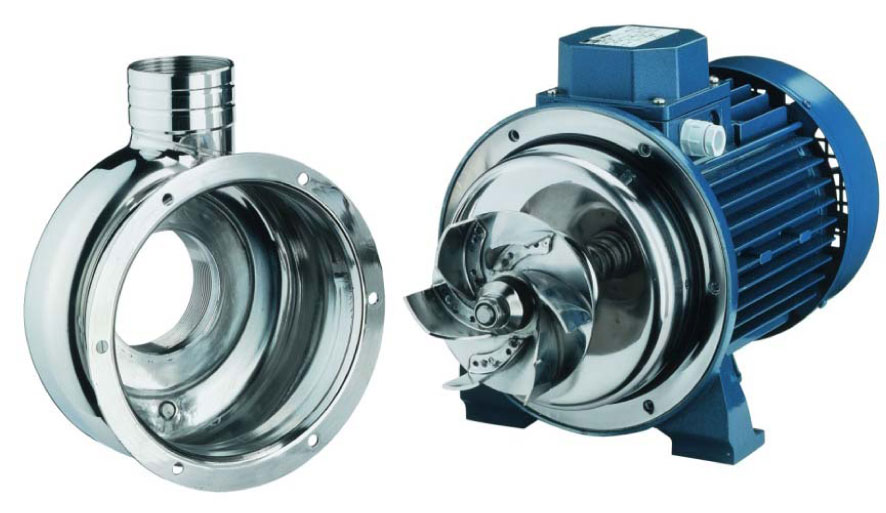
- In the process of the mechanism, under the action of a certain force, the liquid is ejected from the impeller. Thus, a vacuum is created inside its channels, and pressure rises at the periphery.
In order for the water pressure to be stable, the flow of fluid to the wheel, as well as the outlet from it, must be continuous. - For water drainage, inside the case there is a spiral chamber expanding towards the exit. At its end there is a diffuser with a pressure pipe connecting during installation with the pipeline.
But in order to make this connection and start the pump in operation, it must be equipped with a certain set of devices and connecting fittings.
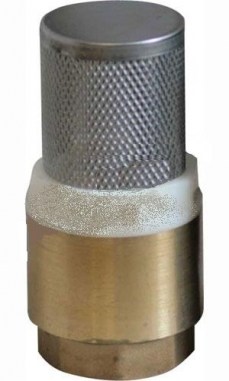
- First of all, it is a non-return valve with a filter screen. The valve holds water in the working chamber, filled before starting the engine, and the grid does not allow large suspensions in the mass of water to enter the pump housing. The same valve is placed on the pressure pipe - it prevents the outflow of fluid back to the unit.
- In addition, control valves are installed on the pressure pipe and on the suction part. A safety valve is installed behind the valve located on the pipeline. Its task is to protect the feed pipe from water hammer.
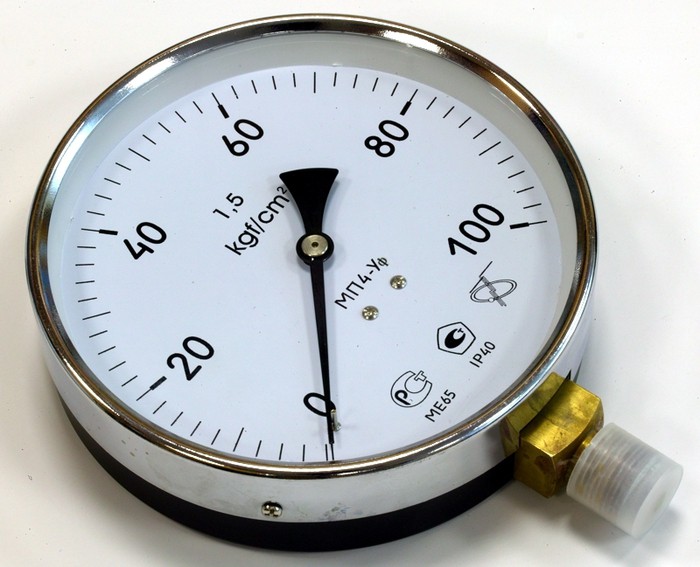
- In the upper segment of the housing, a valve must be installed to remove air when filling the pump. A gulf device is also included. In addition, the pump is equipped with two devices: a pressure gauge for measuring pressure, and a vacuum gauge necessary to determine the rarefaction index on the suction pipe.
- If a centrifugal pump is included in the pumping station kit, then it can be additionally equipped with a start-up protection device, and devices for regulating the operation of the equipment in automatic mode.
Such a kit is always accompanied by the manufacturer's instructions and an installation diagram, with which you can prepare the pump for operation and connect it to the pressure pipe with your own hands.
Most of our fellow citizens who own a suburban area have to solve many problems. One of these is the organization of a centralized water supply system. This element is fundamental to creating a comfortable environment. The fact is that without it it is impossible not only to live comfortably away from civilization, but also to provide watering of plants.
Most often solve a similar problem by using a pump. However, in order to choose the most suitable model, it is necessary to take into account the source of water. If water will be supplied from deep sources, such as wells, wells, the submersible pump would be the best choice. Although there are various models in the category of similar devices, still the best opt for centrifugal plantsthat provide the most efficient water supply from the wells.
Submersible centrifugal pump: principle of operation
 The design of the centrifugal pump provides for special wheels having a predetermined rotation speed. It is they that make it possible to create centrifugal forces that ensure the circulation of water.
The design of the centrifugal pump provides for special wheels having a predetermined rotation speed. It is they that make it possible to create centrifugal forces that ensure the circulation of water.
If we talk in more detail about the design of centrifugal pumping units, then it includes following items. Surely it presents steps, the amount of which directly affects the height of the water rise. Most often, single-stage models are offered on the market. However, their effectiveness is low, due to their inability to provide the necessary pressure force.
To serve deep water sources, it is best to choose multi-stage pumps. In them, each step takes part in creating pressure, and together they ensure the efficiency of the entire apparatus.
The impellers used in such pumps may vary in diameter. Actual depends on him installation performance. In other words, this affects how much water the selected device can deliver for a certain period of time.
Among the advantages possessed by such devices, it is worth highlighting high reliability and performance. Most often, they are made using special materials with high quality and wear resistance. Particular attention is paid to areas where maximum friction is created. They are coated with a special coating or they place graphite inserts there.
For submersible centrifugal pumps there are many advantageswhich make them the preferred option:
- high level of performance and reliability;
- high durability;
- high rate of efficiency;
- the ability to provide optimal pressure;
- water flow is continuous;
- it is possible to ensure the transportation of water to a considerable height;
- lack of difficulties in operation and maintenance;
- affordable price.
At the same time, such installations have one serious drawback: they are designed to transport exclusively pure water. If these pumps are used to pump dirty liquid, this ends with their breakdownas for submersible centrifugal pumps of any type. The fact is that the ingress of impurities and foreign substances into the hydraulic system leads to its clogging, due to which the impeller can no longer work in normal mode.
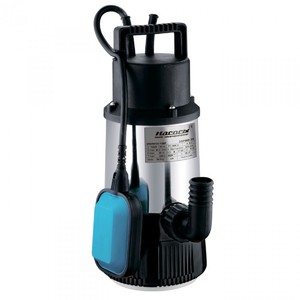 All submersible type centrifugal pumps on the market can be presented in the following groups:
All submersible type centrifugal pumps on the market can be presented in the following groups:
Based on the number of steps used, they distinguish: single-stage and multi-stage.
Depending on the degree of pressure, the pumps are divided into models with low, medium and high pressure.
Depending on the type of water supply to the impeller, models are distinguished single and double feed.
Based on the location of the shaft, these pumps can be classified into models with horizontal and vertical position.
Based on the housing connector, the pumps can be classified into horizontal and vertical.
Depending on the method of removing water from the impeller into a special channel, these units are spiral and turbines.
Based on the speed of operation, the pumps can be divided into slow, normal and fast.
On the basis of such a feature as a method of connecting an electric motor, drive and clutch models.
Residential centrifugal pump models designed for domestic use are more compact and have lower power. Their capabilities do not allow them to be used to carry out large volumes of work, they are most effective for providing water supply to small objects.
Self-installation of a submersible pump
It is advisable to entrust the execution of such work to qualified specialists. However, not all owners can afford their services. In this case, you can install the submersible pump yourself.
Materials
First you need to take care about the availability of the necessary elements:
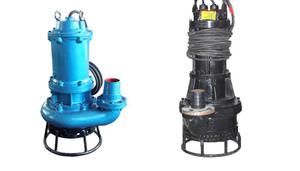
If you need water for watering plants in the yard, you will have to prepare a hose;
Work technology
In technological terms installation procedure Such equipment includes the following steps:
- We connect a pipe or hose to the pump.,
- Then you need to connect the cable;
- If you need to change the location of the water pump, this must be done carefully and never take up the cable and hose. Otherwise, you can inadvertently damage it, which in some cases can result in a complete failure of the device;
- The safest way to move the device is to use a safety cable for this purpose;
- After that, you can lower the pump, then you should check it and carry out a test run;
- It is necessary to allow the device to work for an hour, after which it is turned off, thereby giving it a break.
In the next three days, special attention should be paid to whether there are problems in the operation of the pumping unit. If the device copes with its task, then you can start using it in normal mode.
Repair of centrifugal submersible pumps
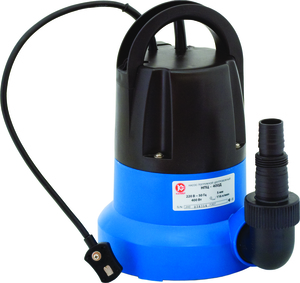 If you find certain malfunctions in the operation of the pumping equipment, the first thing you need to inspect the device. The fact is that individual malfunctions can be eliminated by the owner on his own, without resorting to the services of specialists.
If you find certain malfunctions in the operation of the pumping equipment, the first thing you need to inspect the device. The fact is that individual malfunctions can be eliminated by the owner on his own, without resorting to the services of specialists.
Most often, the pump motor contains mineral oilwhose main task is to provide cooling of the winding and create additional insulation. In household models, it is represented by one phase and two windings, among which one is working, and the other is starting. A non-polar capacitor is connected to the latter. It has a capacitance equal to 10-40 uF. The design of the pump is used asynchronous electric motor with one phase.
- If you find a malfunction in the pump, then first you need to find out if there are problems with the rotation of the motor shaft equipped with an impeller. There are frequent situations when foreign objects penetrate the cochlea, which cause jamming of the shaft. If you do not remove them in a timely manner, this can lead to combustion of the motor stator winding.
- Having not found any problems with the shaft, the rotation of which is free, it is necessary to assemble the lower part of the engine and disassemble the upper one. When doing this work, remember that the pump must remain upright at all times. Otherwise, oil will flow from its body.
- After the bolts holding the cover are unscrewed, it must be removed. Next, you get access to the wires and the start capacitor. To simplify the task of repairing a centrifugal submersible pump, it is desirable to have a diagram of this device. Then it will be easier for you to understand where and which components are located.
- Using a multimeter, it is necessary to determine the resistance of the motor windings. Regarding the working winding, the value of this parameter is usually 10-15 Ohms. For the launcher, it is 35-40 ohms. If during measurements it was found that the resistance indicator tends to infinity, then this is a hint that the winding is damaged. In some cases, the device may show an extremely low resistance value. Based on this, we can conclude that an internal inter-turn fault has occurred in the windings.
- If you were able to find out exactly what kind of malfunction occurred in the pump, you must try to fix it on your own. A failed part should be replaced with a new one, after which the pump can successfully fulfill the task assigned to it.
What determines the cost of the pump
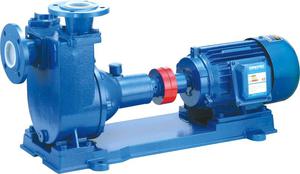 The models of submersible-type centrifugal pumps that are offered today in online stores, as well as at points of sale for home goods and repair differ in prices. Moreover, the last parameter is determined by the technical capabilities of the device and the manufacturer. Sometimes consumers decide to purchase them directly from the manufacturer, immediately drawing up a service agreement with him.
The models of submersible-type centrifugal pumps that are offered today in online stores, as well as at points of sale for home goods and repair differ in prices. Moreover, the last parameter is determined by the technical capabilities of the device and the manufacturer. Sometimes consumers decide to purchase them directly from the manufacturer, immediately drawing up a service agreement with him.
The assortment of the domestic market of domestic water pumps is represented by models manufactured by Russian and foreign companies. If we talk about devices of domestic production, then in terms of performance they can compete on an equal footing with imported samples. At the same time, the price of these devices is often lower. For this reason, pumps, manufactured by Russian companies, and are in high demand among consumers. By purchasing such equipment, the owner gets the opportunity to save on their repair and maintenance. Also, he does not have problems with the acquisition of spare parts, which are available in a wide range in any specialized store.
Conclusion
Choosing a centrifugal pump to solve water supply problems, it will not hurt the owner to know about his device and the principle of operation. Quite often, many people have to independently service such installations, so knowledge of the design features of this device can be very useful for proper pump setup and repair in case of trouble. This primarily concerns Russian-made models, since they have a simple device, and spare parts for them are affordable for every domestic consumer.



